It may not be true in the Olympics or sport, but in business, sometimes it’s better to be the second or third cab off the rank. Especially with disruptive new business models. And by spotting new business models as they prove themselves in the United States or Europe, where they usually originate, quick-acting New Zealand and Australian opportunists can make the big time off the back of offshore success stories.
The classic local-boy-made-good story in New Zealand, of course, is Sir Stephen Tindall of The Warehouse. I can remember wandering into his first store in Takapuna and my first thought was: Who’s going to buy all this junk? But I answered my own question when I ended by buying a broom for around half of what I would have paid at the hardware store down the road. Thirty years later The Warehouse is a national institution, proving that the disruptive new business model pioneered by Sam Walton of Walmart in the United States more than forty years ago works as well here as it does in the United States and other parts of the world.
How well would Walmart now go if they set up here in competition to The Warehouse?
Is the New Zealand market too small and too remote for them? Or is the fact that The Warehouse is so well-established here a disincentive to them?
The fact is that Walmart hasn’t generally been as successful offshore as inside the United States, with the exception of the United Kingdom, South America and China. They actually pulled out of Germany and South Korea. And they’ve never set foot in Australia, something The Warehouse should have taken note of before making its unsuccessful foray into Australia a few years back.
Local resistance and competition are the keys
There seem to be two main reasons for Walmart’s mixed reception: local resistance in some countries to one-business-model-fits-all concepts, and stiff local competition, often from operators such as Aldi in Germany, with similar business models.
The trick to successful new business model adoption – which may be viewed by some as piracy, but how do you patent or copyright a business model? – seems to be to wait until the model is proven by someone else overseas, then quickly adapt it to the local market and expand rapidly to grab as much market share as possible before the model’s originators expand as far as our fair shores.
Two examples of model adopters which have used franchising to achieve rapid expansion
Jetts Fitness, whose success story has been told in a separate article and whose model is remarkably similar to that of US-based Anytime Fitness, and Zambrero, a fast-growing fast-casual Mexican food franchise found only in Australia so far, whose store format, menu, commitment to fresh, organic ingredients and philanthropic interests are very like that of Chipotle Mexican Grill, a fast-casual concept (albeit non-franchised) in the United States whose growth has been described by Forbes magazine as “the envy of the restaurant industry”.
I'm Robin La Pere, no ordinary business, marketing and franchise consultant. Some years ago, it amazed me to learn that being innovative and the first mover in business can sometimes be a disadvantage, not an advantage. There are plenty of examples of pioneering companies that for various reasons never achieved the breakthrough they expected - and later were usurped by the second or third cabs off the rank which were far more successful.
Equally, there are many entrepreneurs who've 'borrowed' business models they've seen in other parts of the world and made them a success in their own country or region.




